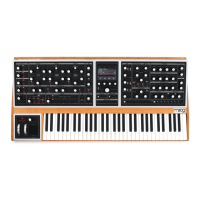78
ARPEGGIATOR
At its most basic level, an arpeggiator scans the notes being held down on the keyboard and plays
them one at a time in a cyclic and rhythmic fashion. This description doesn’t even begin to come
close to describing the Moog One Arpeggiator. Octave Order, Pendulum Mode, and Random patterns
allow this Arpeggiator to become an extra set of hands, create an electronic counterpoint, generate
cascades of notes, and to form the solid base of a rhythmic groove.
The Arpeggiator exists at the Synth level, and all Arpeggiator parameters are saved with their
respective Timbre as part of the Preset. In this way, a single Preset can have up to three active
Arpeggiators (one per Synth) at any time, each playing a different pattern, using a different sound,
and in a different zone on the keyboard. The Arpeggiators – along with the Sequencers, LFOs and EGs
– can be sync’d to the tempo of the Master Clock to create a unied rhythmic performance. Unlike a
sequencer, which is playing patterns of specic notes stored in memory, the Arpeggiator is generating
data in real time, based on the notes being played; it is a bit more interactive, and is always musically
related to the performance.
ON (ON/LIT, OFF/UNLIT)
This button turns the Arpeggiator of the active Synth On and Off.
RATE (0 to 10)
The RATE knob sets the speed of the Arpeggiator. The actual tempo
value ranges from 10 BPM to 280 BPM. The Arpeggiator Rate can run
at an independent speed, or it can be synchronized to the Master Clock
using the parameters accessed in the Arpeggiator MORE page. The
RATE knob LED will ash at the current setting.
NOTE: If the Arpeggiator is sync’d to the Master Clock, then rotating the
RATE knob will select quantized clock divisions of the Master Clock. All of
the SYNC parameters are available in the Arpeggiator MORE page.
OCTAVE ORDER (ON/LIT, OFF/UNLIT)
Traditionally, when an arpeggiator is set to play over a multi-octave
range, all of the notes are played in the current octave, and then the
pattern is repeated an octave higher, etc. When the OCTAVE ORDER
switch is On, the Arpeggiator pattern will play the rst note in the
pattern in each octave, then the second note of the pattern repeated in
each octave, etc.
EXAMPLE: The notes in the pattern are a C Major triad (C, E, G) and
the OCTAVE range is set to three. With OCTAVE ORDER set to Off, the
pattern generated would be C1-E1-G1, C2-E2-G2, C3-E3-G3, etc. With
OCTAVE ORDER set to On, the pattern generated would be C1-C2-C3,
E1-E2-E3, G1-G2-G3, etc.

